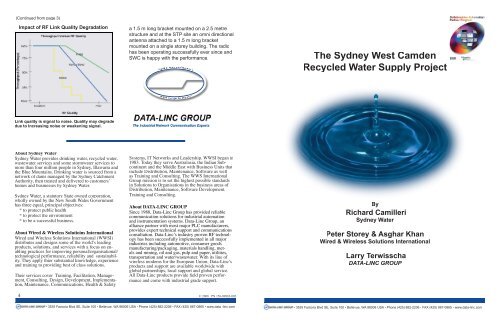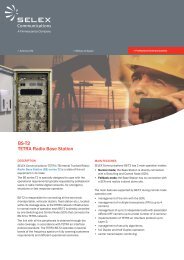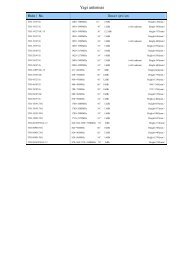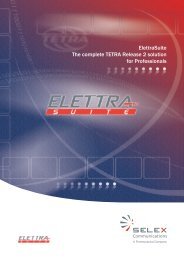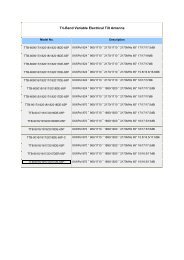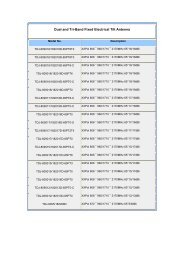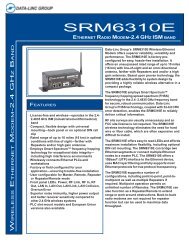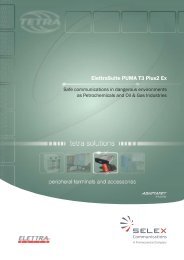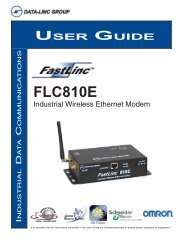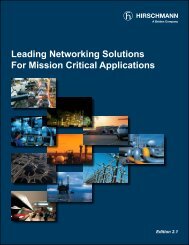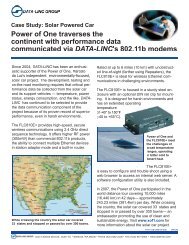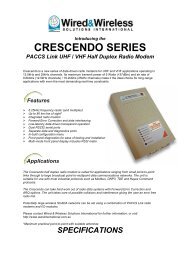Create successful ePaper yourself
Turn your PDF publications into a flip-book with our unique Google optimized e-Paper software.
(Continued from page 3)<br />
Impact of RF Link Quality Degradation<br />
a 1.5 m long bracket mounted on a 2.5 metre<br />
structure and at the STP site an omni directional<br />
antenna attached to a 1.5 m long bracket<br />
mounted on a single storey building. The radio<br />
has been operating successfully ever since and<br />
SWC is happy with the performance.<br />
Fi<br />
ro<br />
F eld pro<br />
ve<br />
v n perf<br />
r ve<br />
rm rf<br />
r o<br />
fo<br />
r ance<br />
rm<br />
The Sydney West Camden<br />
Recycled Water Supply Project<br />
In<br />
I du<br />
du<br />
d str<br />
tr<br />
a<br />
t i<br />
ri<br />
l gra<br />
ia<br />
ra<br />
d<br />
de<br />
r de<br />
pp<br />
u p<br />
rt<br />
r<br />
sup<br />
ort<br />
Link quality is signal to noise. Quality may degrade<br />
due to Increasing noise or weakening signal.<br />
About Sydney Water<br />
Sydney Water provides drinking water, recycled water,<br />
wastewater services and some stormwater services to<br />
more than four million people in Sydney, Illawarra and<br />
the Blue Mountains. Drinking water is sourced from a<br />
network of dams managed by the Sydney Catchment<br />
Authority, then treated and delivered to customers’<br />
homes and businesses by Sydney Water.<br />
Sydney Water, a statutory State owned corporation,<br />
wholly owned by the New South Wales Government<br />
has three equal, principal objectives:<br />
* to protect public health<br />
* to protect the environment<br />
* to be a successful business.<br />
About Wired & Wireless Solutioins International<br />
Wired and Wireless Solutions International (WWSI)<br />
distributes and designs some of the world’s leading<br />
products, solutions, and services with a focus on enabling<br />
practices for improving personal/organisational/<br />
technological performance, reliability and sustainability.<br />
They apply thier substantial knowledge, experience<br />
and training to providing best of class solutions.<br />
Their services cover Training, Facilitation, Management,<br />
Consulting, Design, Development, Implementation,<br />
Maintenance, Communications, Health & Safety<br />
Systems, IT Networks and Leadership. WWSI began in<br />
1983. Today they serve Australasia, the Indian Subcontinent<br />
and the Middle East with Business Units that<br />
include Distribution, Maintenance, Software as well<br />
as Training and Consulting. The WWS International<br />
<strong>Group</strong> mission is to set the highest possible standards<br />
in Solutions to Organisations in the business areas of<br />
Distribution, Maintenance, Software Development,<br />
Training and Consulting.<br />
About DATA-LINC GROUP<br />
Since 1988, <strong>Data</strong>-<strong>Linc</strong> <strong>Group</strong> has provided reliable<br />
communication solutions for industrial au to ma tion<br />
and instrumentation systems. <strong>Data</strong>-<strong>Linc</strong> <strong>Group</strong>, an<br />
alliance partner with most major PLC manufacturers,<br />
provides expert tech ni cal support and com mu ni ca tions<br />
con sul ta tion. <strong>Data</strong>-<strong>Linc</strong>’s in dus try proven RF technology<br />
has been suc cess ful ly im ple ment ed in all major<br />
in dus tries including au to mo tive, con sum er goods<br />
man u fac tur ing/packaging, materials handling, metals<br />
and mining, oil and gas, pulp and paper, utilities,<br />
trans por ta tion and water/wastewater. With its line of<br />
wireless modems for the European Union, <strong>Data</strong>-<strong>Linc</strong>’s<br />
products and support are available worldwide with<br />
global partnerships, local support and global service.<br />
All <strong>Data</strong>-<strong>Linc</strong> products provide field proven performance<br />
and come with industrial grade support.<br />
By<br />
Richard Camilleri<br />
Sydney Water<br />
Peter Storey & Asghar Khan<br />
Wired & Wireless Solutions International<br />
Larry Terwisscha<br />
DATA-LINC GROUP<br />
4 © 2008 PN 156-09883-002<br />
• 3535 Factoria Blvd SE, Suite 100 • Bellevue, WA 98006 USA • Phone (425) 882-2206 • FAX (425) 867-0865 • www.data -linc.com<br />
• 3535 Factoria Blvd SE, Suite 100 • Bellevue, WA 98006 USA • Phone (425) 882-2206 • FAX (425) 867-0865 • www.data-linc.com
Case Study: Public Utility— Water/Wastewater<br />
The Sydney West Camden<br />
Recycled Water Supply Project<br />
By Peter Storey & Asghar Khan—Wired & Wireless Solutions International,<br />
Richard Camilleri—Sydney Water, Larry Terwisscha—<strong>Data</strong>-<strong>Linc</strong> <strong>Group</strong><br />
Abstract— Sydney Water constructed a 300mm diameter pipeline to transfer tertiary treated effl uent pumped from<br />
its treatment plant to an earth dam located 9 km away. The GSM coverage in the area is very weak; there is no<br />
PSTN line and there is no line-of-sight between the two locations. Despite these challenges, Sydney Water working<br />
with Wired and Wireless Solutions International was able to design a network that not only worked, but worked well.<br />
Background<br />
Sydney Water has constructed a 300mm diameter<br />
pipeline to transfer tertiary treated effl uent pumped<br />
from its West Camden Sewage Treatment Plant<br />
(STP) to a 60 megalitre earth dam located on<br />
the Elizabeth Macarthur Agricultural Institute<br />
(EMAI) property, 9 km away. The STP recycled<br />
water pumps are controlled by a Schneider<br />
Programmable Logic Controller (PLC) using cutin/cut-out<br />
level signals installed at the dam. The<br />
GSM (Global System for Mobile Communications)<br />
Coverage in the area is very weak and there is no<br />
PSTN (Public Switched Telephone Network) line<br />
at the dam site the only option left for linking the<br />
dam site instrumentation with STP plant control<br />
system was a radio link. There is no line of sight<br />
between the two locations making the radio link<br />
planning more challenging.<br />
Site Survey<br />
We conducted the site survey and obtained the<br />
Geo Coordinates for the STP and dam site. After<br />
feeding all the details into the path loss software,<br />
we found that the probability of line-of-sight (LOS)<br />
communication between STP and the dam site<br />
was low.<br />
Altitude (m)<br />
Elevation Map Between STP and Dam<br />
Radio Survey<br />
We conducted a radio survey by setting up<br />
a temporary pair of radios to determine the<br />
reliability of the link. It was very critical to<br />
choose the right type of antenna due to poor<br />
line-of-sight.<br />
We conducted the test by using the following<br />
equipment.<br />
1) SRM 6210E Radio, Qty 2<br />
2) 9 dBi omni antenna<br />
3) 12 dBi Yagi antenna<br />
At the STP we have installed a 9 dBi omni<br />
directional antenna and at dam site we installed<br />
a 12 dBi Yagi antenna. We powered the radio<br />
with a battery, pointing the antenna towards the<br />
STP and the link was established. The RF link<br />
light was on and we were able to successfully<br />
ping the radio at the other end.<br />
Reasons why the <strong>Data</strong>-<strong>Linc</strong> Radio was<br />
successful in this project<br />
1) Modulation Technique: Smart Spectrum<br />
(proprietary Frequency Hopping Spread<br />
Spectrum)<br />
Technology— Spread Spectrum<br />
2) Distance and Throughput: RF Speed is<br />
higher than actual throughput<br />
Distance and Throughput<br />
Note: RF speed is higher than actual throughput.<br />
3) Object Penetration: At 900MHz object penetration<br />
is better than 2.4GHz<br />
Planning<br />
Factors to be considered for radio link planning.<br />
• Frequency band<br />
• Transmitter output power<br />
• Receiver sensitivity & selectivity<br />
(ability to separate signal from noise)<br />
• Spreading method (FHSS vs. DSSS)<br />
• RF noise level<br />
• Antenna type and gain<br />
• Transmission Line (coax) Quality<br />
STP<br />
Distance (m)<br />
Dam<br />
Type of Radio<br />
Since there was signifi cant interference<br />
with LOS and the area is covered with<br />
tall trees, the 2.4GHz frequency option<br />
was ruled out and the obvious choice<br />
was to use the more robust 900MHz<br />
Frequency Hopping Spread Spectrum<br />
(FHSS) radio.<br />
Direct sequence (DSSS)<br />
• High data rates<br />
(54 Mbps+)<br />
• Low latency<br />
• 802.11 technology<br />
• Short to medium range<br />
• Wide channels prone to<br />
crowding<br />
Frequency Hopping (FHSS)<br />
• Moderate data rates<br />
(0.1-1Mbps)<br />
• More latency<br />
• Proprietary technologies<br />
• Long range (25+ miles)<br />
• Excellent interference<br />
immunity<br />
RF Bands and Line-of-sight<br />
Conclusion<br />
Sydney Water saved the cost of installing mast<br />
towers, by installing the dam site radio in an<br />
outdoor kiosk with the Yagi antenna attached to<br />
2<br />
(Continued on page 4)<br />
3<br />
• 3535 Factoria Blvd SE , Suite 100 • Bellevue, WA 98006 USA • Phone (425) 882-2206 • FAX (425) 867-0865 • www.data-linc.com<br />
Field Proven Performance ~ Industrial Grade Support


